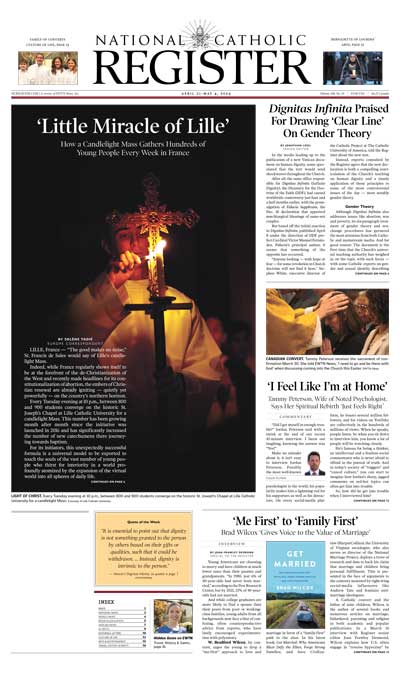The Story of Baby Joseph
Dr. Paul Byrne discusses his role in the baby Joseph case.
ST. LOUIS — Joseph Maraachli, the 16-month-old Canadian boy who received a tracheostomy March 21 at SSM Cardinal Glennon Children’s Medical Center in St. Louis, had a lot of people helping him.
Priests for Life helped transfer the boy, who suffers from a progressive neurological disorder, from the Canadian hospital that had refused to perform a tracheostomy on him, a procedure that had the potential to protect and preserve his life. Many people across the country responded to an appeal for donations.
And an Ohio neonatologist, a longtime pro-life doctor, was part of a network of people who were instrumental in the transfer of baby Joseph from the London (Ontario) Health Sciences Center to Cardinal Glennon.
Dr. Paul Byrne’s involvement in the case took a providential turn when he was able to assist Joseph’s family in having the child baptized. Byrne is past president of the Catholic Medical Association (USA).
The boy was baptized by a Catholic priest in St. Louis on March 18.
Prior to this, Joseph was a patient at the hospital in Ontario, Canada, where doctors were planning to remove his nasotracheal tube, making it highly unlikely he would have been able to breathe on his own, and to sedate him if he struggled.
Byrne discussed what went on behind the scenes of this story.
Doctors had called Joseph’s condition a progressive neurodegenerative disease. What kind of treatment was he receiving at the hospital in Canada, what was his situation at the time the transfer was sought, and what were the medical implications?
Baby Joseph had a nasotracheal tube for five months. This is very unusual and potentially quite dangerous to the patient. When a patient has such a tube lodged in the throat for an extended period — for example, longer than one to four weeks — if the tube is removed, it is by then very unlikely that the patient will be able to breathe on his own due to the potentially lethal damage caused by the delay in removal of this kind of tube. Thus, it is essential that such a tube be replaced promptly by a tracheostomy, rather than be delayed, as occurred with baby Joseph.
A tracheostomy is a tube placed surgically through the neck into the airway. It is a relatively simple, routine procedure that definitely increases both comfort and safety for the patient. Joseph likely suffered because of the delay.
His doctors in Canada, who recommended that the tube be removed without the medical precautions necessary to compensate for throat damage, planned to administer morphine or similar medications if Joseph struggled in his attempt to breathe. This would have led to his death.
What happened when Joseph’s parents refused to accept this?
The doctors, not the parents, went to the Consent and Capacity Board [created by the province of Ontario in 1993 to resolve family-hospital disputes].
After the hearing, which did not include any doctor to present testimony in favor of the tracheostomy, the board directed Joseph’s parents to consent to removal of the breathing tube without replacement, a do-not-resuscitate order and palliative care.
The parents had 48 hours to agree to the treatment. If they did not consent, the decision made clear they would be deemed unsuitable for making decisions for their child.
How did you get involved in the case?
An attorney from Canada asked by phone if I could help find a hospital where baby Joseph could be treated. Since I was leaving to go overseas in a few hours, I was not able to help at that time.
A private network had begun working in the background on Feb. 18 to get Joseph to where he would be willingly treated. Plans for Joseph’s imposed death were impending, and it was imperative to get him to a safe environment as soon as possible, while finding ways to keep him alive in the meantime.
When I returned March 6, I realized the ongoing urgency to get Joseph out of the clutches of the doctors in Canada, and I became aware of the increased massive efforts, strategies and tactics that were diligently being implemented on the part of the coordinated private network largely in the background (and by design in the foreground) every day — sometimes hour-to-hour or minute-to-minute — just to keep Joseph alive in order that there would actually still even be a living baby to transport to the potentially found hospital.
A baby with an endotracheal tube needs constant attention to keep the tube in place and to keep the tube suctioned. Even a short time with no attention can be life-threatening.
Joseph also was fed with a tube, requiring many precautions and care. During this critical and very challenging period, I heard how the doctors in Canada would, for instance, take Joseph off the ventilator for one to two hours, theoretically attempting to wean the ventilator support. Their chosen “crash” method was an unsafe and inappropriate form of “weaning” that in fact dangerously stressed some of the infant’s vital functions in a potentially lethal manner.
What was going through your mind during this phase?
I often wondered in astonishment at how this baby could possibly still be alive, given the hospital’s seeming motivation to impose death on Joseph in the meantime.
How much time passed before the private network was able to expedite the transfer of baby Joseph?
It was about four weeks before a hospital was found that would accept him. Keeping him alive day-to-day all that time was a vigorous and demanding challenge second to none in the whole operation.
It’s no coincidence that Joseph remained alive all those four weeks. God continued to say Yes to Joseph continuing to live. It took an enormous operation and effort. Lots of people were involved in that process, some even unwittingly. It was a matter of day and night figuring out enough of what the London hospital was up to or most likely up to, and then conceptualizing/harnessing and executing methods and means to keep Joseph alive until the U.S. hospital finally got secured.
But few people understand that fundamental “story behind the story”: that if Joseph hadn’t been kept alive during those four weeks by numerous clever ideas and actions, there would not have even been a Joseph to fly to the U.S.
What was your most gratifying moment in the baby Joseph case?
One of the most exciting aspects of my participating in the treatment and care of Joseph was arranging his baptism. I asked Joseph’s father if anyone had asked about baptism. He said, “No.” He then told me he was not Catholic, but that he wanted Joseph to be raised in the religion of Joseph’s mother, who is Catholic. The next day Joseph was baptized at Cardinal Glennon Children’s Medical Center.
Joseph is now a living baby at home under the loving care of his parents and his brother, Ali. There is no way to know how long Joseph will live. But we know he will live longer with the tracheostomy and the love of his family, and, finally, he and his loving family are living as families ought to be permitted and fully supported to live.
Read more at NCRegister.com.
Judy Roberts writes from Graytown, Ohio.
- Keywords:
- June 19-July 2, 2011













